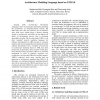Free Online Productivity Tools
i2Speak
i2Symbol
i2OCR
iTex2Img
iWeb2Print
iWeb2Shot
i2Type
iPdf2Split
iPdf2Merge
i2Bopomofo
i2Arabic
i2Style
i2Image
i2PDF
iLatex2Rtf
Sci2ools
APSEC
2004
IEEE
2004
IEEE
Architecture Modeling Language based on UML2.0
Existing ADLs (Architecture Description Languages) have an advantage of formally specifying the architecture of component-based systems. But ADLs have not come into extensive use in industries since ADL users should learn a distinct notation specific to architecture, and ADLs do not address all stakes of development process that is becoming diversified everyday. On the other hand, UML is a de facto standard general modeling language for software developments as UML provides a consistent notation and various supporting tools during the whole software development cycle. A number of researches on architecture modeling based on UML have been progressed. In particular, many research results have been introduced that specialize UML by its extension mechanism in order to explicitly represent core architecture concepts that UML does not fully support. UML2.0 embraces much more concepts that are
APSEC 2004 | Architecture | Architecture Description Languages | Distinct Notation Specific | Software Engineering |
| Added | 20 Aug 2010 |
| Updated | 20 Aug 2010 |
| Type | Conference |
| Year | 2004 |
| Where | APSEC |
| Authors | Sunghwan Roh, Kyungrae Kim, Taewoong Jeon |
Comments (0)

